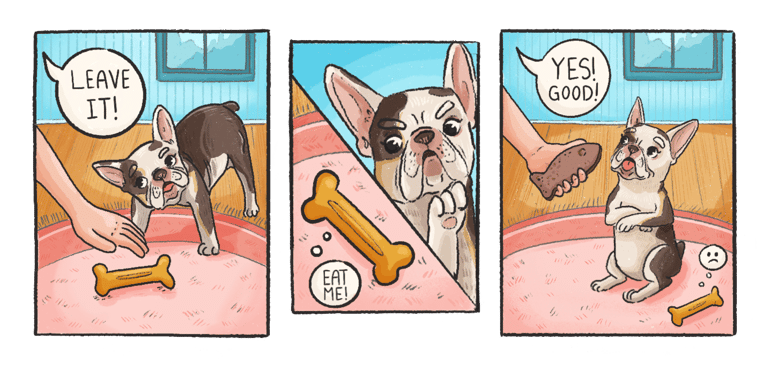Impulse control
Leave it from distractions
This could also be called redirection from distractions, as what we are aiming to do is get them to check in before they go towards a distraction and listen when the answer is no.
Once we have got ‘leave it’ as a command from the last game, we can broaden it out to mean leave it from a distraction.
It is important to do an engagement warm up for this exercise as otherwise they will engage with the high value item. We want them engaged with us and set up for success.
Engagement warm up
Set up a high value item on the floor; this could be some treats or a favourite interactive toy. Have them on the lead or houseline.
Go to walk them past the HVI with a treat, position them on the opposite side of you to the HVI.
If they pull to get near the treat,
Say leave it. It is very important they don't get the HVI
Redirect them with the treat in your hand away from the HVI. Apply a gentle tug on the houseline if they aren't coming.
When they start to move away and engage with us we mark the behaviour and reward them with the treat in our hand (NOT the HVI)


Leave it
Leave it - Floor
Have them in a sit position with you sat in front of them, with an arm's length between you.
Put a treat on the floor in between you and say ‘Leave it’
Whenever they go to take the treat you cover it with your hand and say no.
When they move away, you uncover the treat.
Repeat steps 3 and 4 until eventually they stop going for the treat and look to you to tell them when they can have it.
As soon as you notice the engaged eye contact, mark the behaviour with a Yes
Pick up the treat and reward them with it (the reward always comes from you).
Progression step - Reward with a different treat in your hand rather than the treat from the floor, making them leave that one entirely.
Leave it - Hand
Have them in a sit position with you sat in front of them, with an arm's length between you.
Put a treat in the palm of your hand
When your dog goes toward the treat, close your hand and vocally correct with Ah Ah
When they disengage with the treat, open your hand up again
Repeat steps 3-4 until they no longer go for the treat
Reward with the treat when they are making eye contact
Progression step - Reward with a treat in your other hand
Impulse control is vitally important when training as we are teaching them when they can and can't do what they want to do. If your dog has never been taught when they can't do something they will naturally assume that they can do whatever they want, whenever they want. We need them to have an automatic check-in step between impulse and action. This is where we really see the marker and leadership exercises from earlier work together to positively reinforce the new check-ins we are introducing, helping you achieve wins as a team.
Wait
Start face to face, with your dog in sit and you ready to move around.
They should be engaged with you- do a warmup if they aren’t.
Use your wait command firmly
Take a step back
If they follow your movement, vocally correct them and put them back in the starting position
If they stay still, you stay still for a beat
Reward
Add time and distance when your dog is nailing it- try not to push it too soon
Staying on a bed
This exercise is not for every time they are on a bed but as a set exercise to get them to understand impulse control. (rewarding at random when they are on their bed of their own accord also creates value!)
Engagement warm up
Lead your dog to their bed. This can be with a houseline and/or a treat
Get them into a settled position e.g. sitting or laying down
Reward them for being settled on a bed.
Add longer and longer between the treats, and slowly put more distance between the two of you.
If your dog takes themselves off the bed you put them back in the same manner as step 2.
The goal is to get to a point where they will wait on the bed settled for extended periods. It's important to note they don't have to be engaged with you to get the reward. In fact it's better to reward when they aren't engaged, as this encourages them to settle on the bed.


Redirecting from a heightened state
When they are too excited and can’t listen properly, we call this all beans and no brain. If they can't listen, we have to show rather than tell to start with. Like everything this isn't an instant fix but with consistency we will build the correct behaviours into your dog's decision making.
Correct the behaviour. In this case we would do the ‘controlled time out’ mentioned in the corrections section.
Use a chew toy to engage. You can do this by moving it around as if playing.
When they engage with the toy, verbally mark it with a yes.
Reward, but not with something that will stop the engagement. For this, a scratch on the back works but doesn't offer something better than chewing the bone.
Disengage while still praising.
If they disengage with the toy and go back to demanding attention we repeat and stay consistent.
This can be a frustrating process and if they arent listening they may need to have a timeout in their bed to allow them to calm down in a controlled way. When they have settled down let them out and engage in a bean burning exercise so you can both work out some energy.




